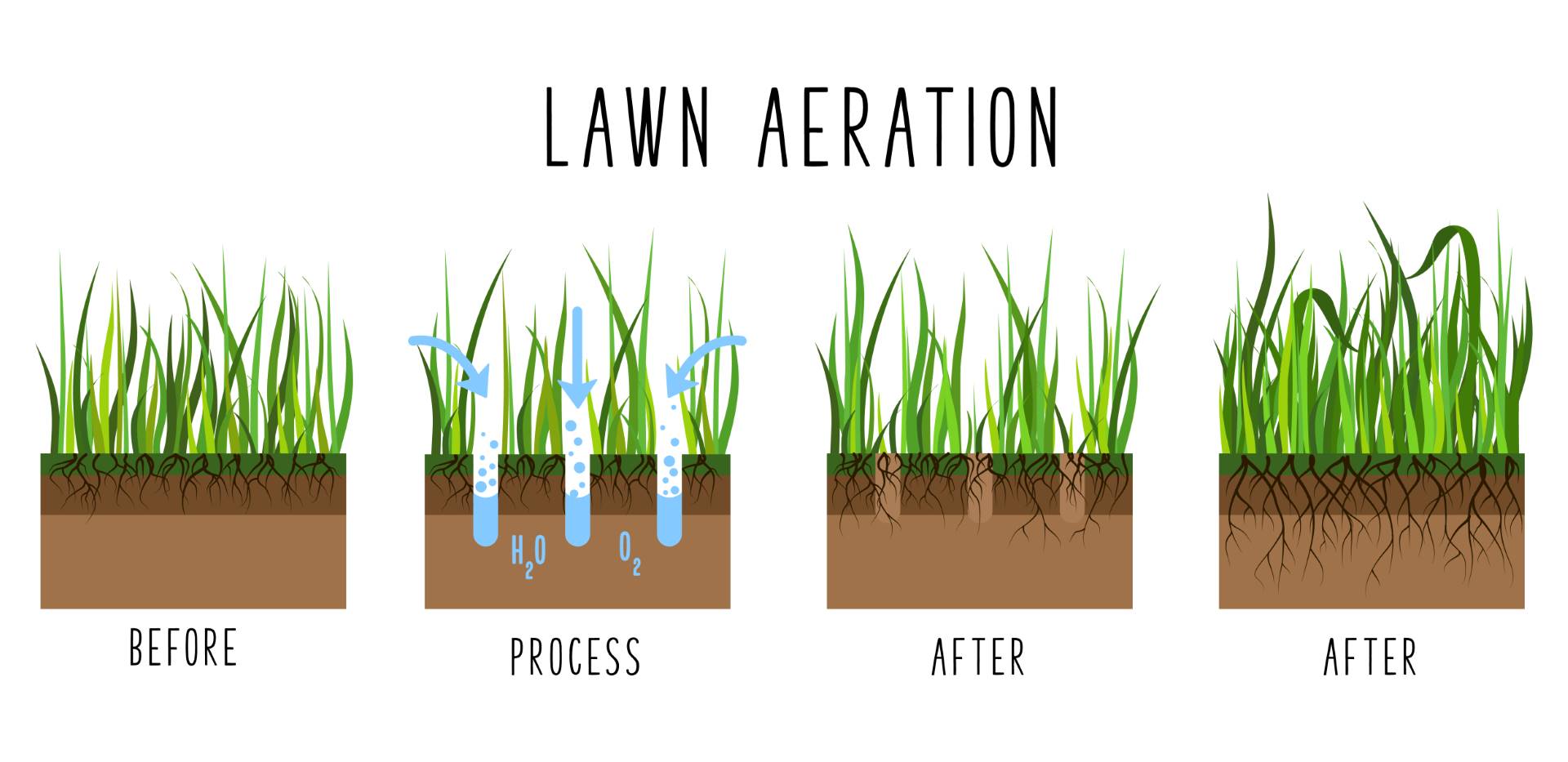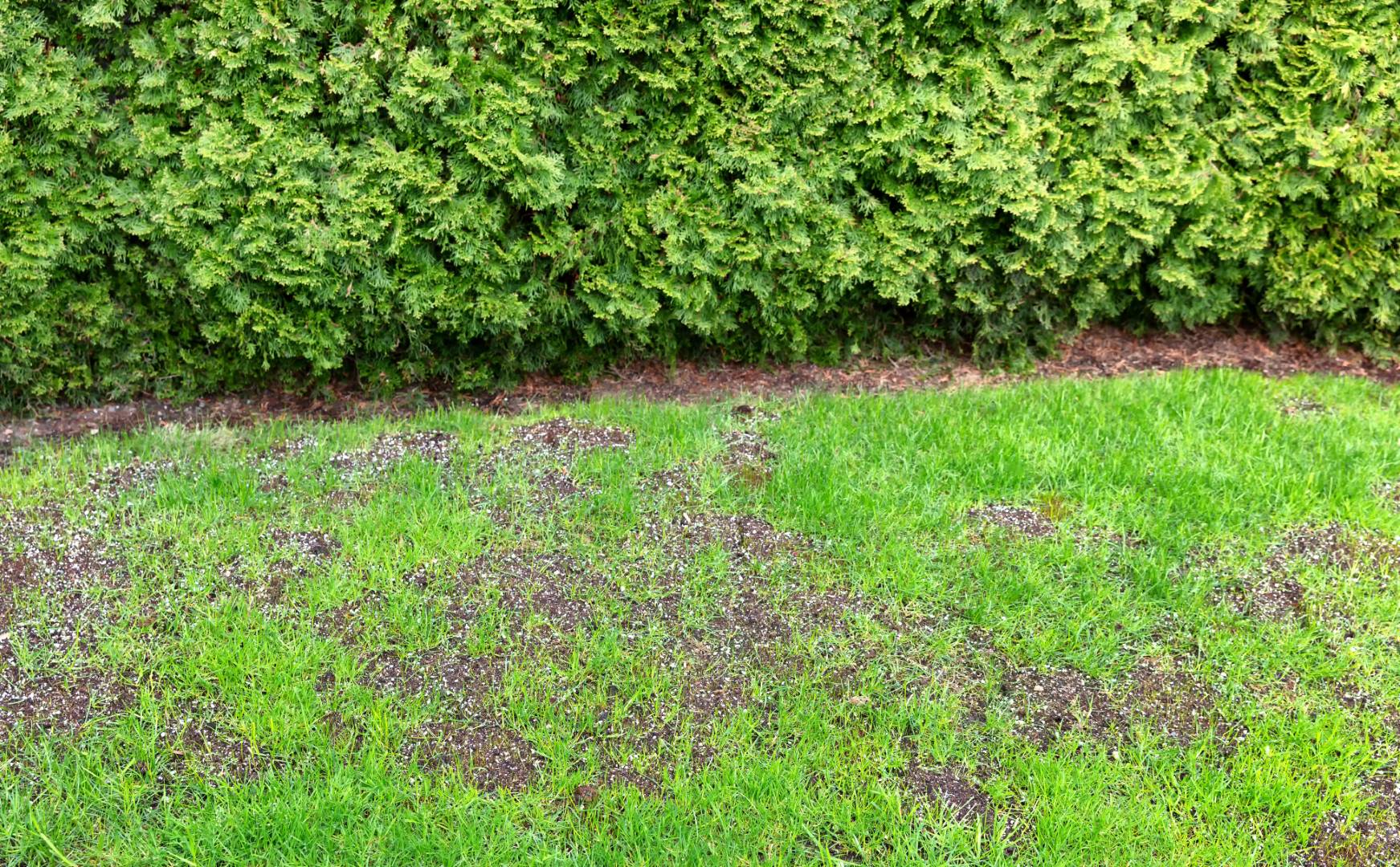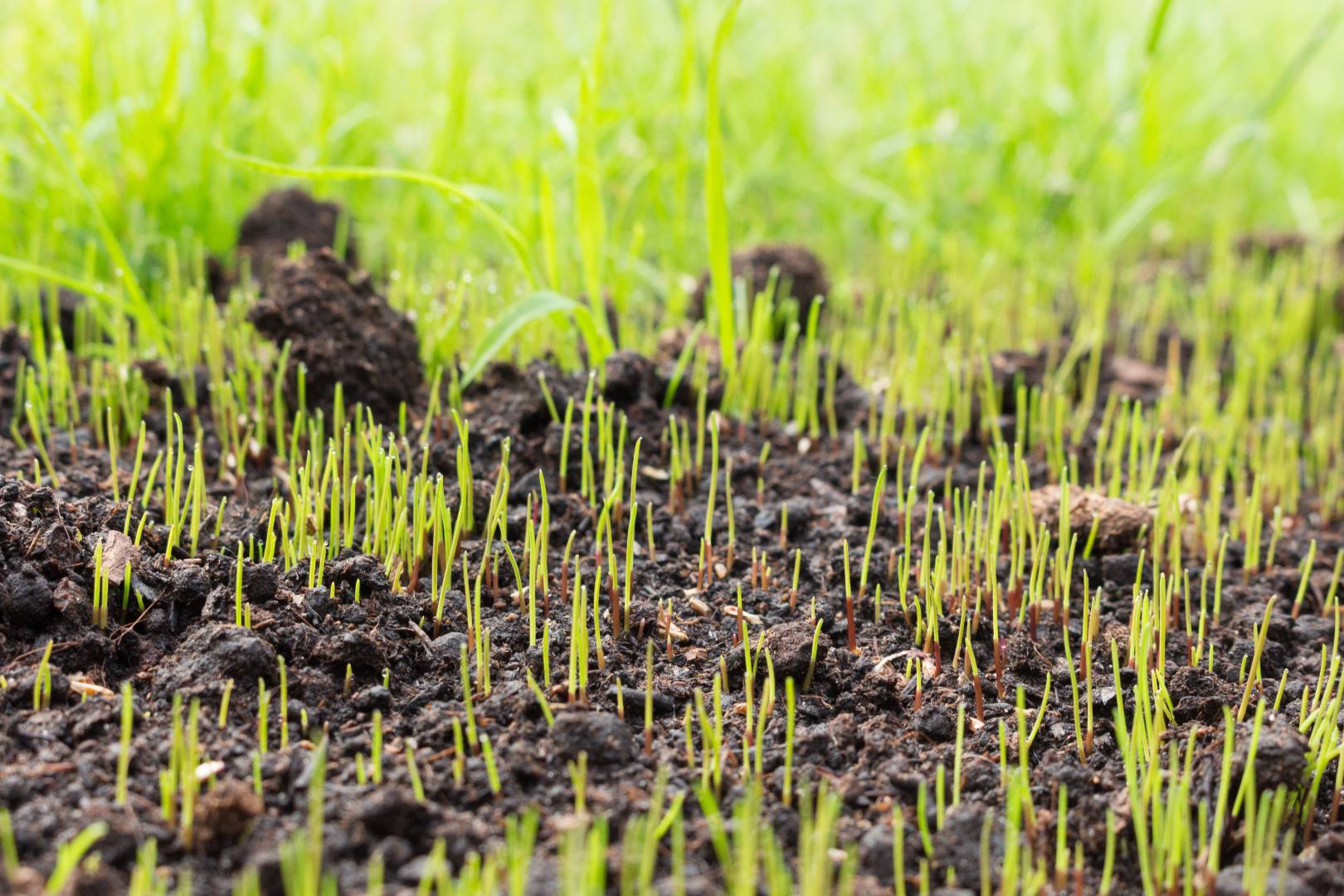Core Aeration • Over Seeding • Top Dressing
Grass Roots Lawn and Landscaping offers Core Aeration, Over Seeding and Top Dressing to Stafford, Spotsylvania, Fredericksburg, and Ladysmith, Virginia. Each of these services will improve the quality and beauty of your lawn. When all 3 services are combined in the fall you will achieve remarkable results.
Core Aeration
Q: What is Core Aeration?
A: Core Aeration is the process of mechanically removing plugs of soil and thatch from the ground. The holes left behind allow air, water and nutrients to reach the Grass Roots. Aeration also reduces soil compaction.
The machine used is an aerator. A core aerator has hollow tines that remove cores from the soil and deposits them onto the surface of the ground.

Q: What are the benefits of Core Aeration?
A: The benefits of Core Aeration are:
- Reduces soil compaction and allows roots to grow deeper.
- Fertilizer and other nutrients are more effective because they reach the roots quicker.
- Soil has better water absorption.
- Stronger, thicker, healthier root system.
- Allows oxygen to reach the roots.
- Improves drainage.
- Helps to prevent or reduce thatch buildup.
- Lawn becomes more heat and drought tolerant.
- Sets your lawn up perfectly to receive additional beneficial treatments such as overseeding and topdressing.
Q: When is the best time to aerate my Virginia Lawn?
A: Aerate your lawn when the grass is actively growing. For warm season grasses, aerate during the summer.
The majority of lawns in the Fredericksburg area are Tall Fescue, a cool season grass. Cool season grasses can be aerated in the spring. However, Grass Roots recommends fall core aeration. Fall is the ideal time. With cooler nights and warm soil, the grass plants can concentrate on root development. Aeration will help to alleviate soil compaction making it easier for the grass roots to grow deeper and stronger.
Q: Should I aerate my lawn?
A: Many lawns will benefit from annual core aeration. Do any of the following statements describe your lawn? If YES, your lawn is a good candidate for core aeration.
- Compacted, hard soil. Unable to push a screwdriver several inches into the soil.
- Poor soil make up, such as heavy clay.
- Overuse from people, pets or machinery.
- Very shallow root system.
- A newly constructed home in the last several years. New home builds usually have terrible soil. The soil is hard and compacted from the machinery and the topsoil is stripped or buried. Often rocks and building debris have been buried on the property as well.
Q: What to expect when Grass Roots core aerates your lawn?
A: When Grass Roots aerates your lawn you can expect that:
- We will email your date of service to you, five days ahead of time.
- We will email you detailed instructions on how to prepare your lawn before we arrive.
- Your lawn will be aerated by our trained technicians. Multiple passes will be made in every direction.
- The plugs will be left on the surface of the lawn. They will naturally break down in 2-4 weeks and add nutrients back into the soil.
After your lawn has been aerated, it is a perfect time to Over Seed and Top Dress your lawn. See our Lawn Care section under Services for more information.
Over Seeding
Q: What is the difference between seeding a lawn and over seeding a lawn?
A: Seeding a lawn usually refers to the process of starting a lawn from scratch. It may be a new yard or a total lawn renovation when more than 50% of the grass needs repair or is filled with weeds.
Over Seeding a lawn is the process of adding grass seed to an existing lawn that has become thin, weak and has bare areas.
Q: Why is it necessary to Over Seed Tall Fescue lawns?
A: Most lawns in Fredericksburg and the surrounding counties are made up of Tall Fescue, a deeply rooted cool season grass. Fescues are bunch style grasses that grow and expand by seeds and tillering, not by runners that spread.
Each germinating seed produces a single grass blade. Additional blades (shoots) grow from the base of the initial grass plant and are called tillers. Each tiller has a crown and its own root system. One plant produces many tillers.
Surprisingly, each blade of grass only lives an average of 40 days. As each plant gets older, they produce less and less tillers, so lawns become thinner over time. Lawns also thin out and have bare areas because of soil compaction, excessive heat, lack of water, high humidity, overuse, diseases, and pests.


Q: What are the benefits of overseeding a lawn?
A: The benefits of overseeding a lawn are:
- Increases grass density.
- Thicker lawns help prevent weeds from filling in thin areas and bare spots.
- Improves color and appearance of lawn.
- Thicker grass reduces erosion.
Q: When is the best time to overseed a lawn?
A: Cool season grasses can be overseeded in the spring. However, fall is the ideal time to overseed your lawn. In the spring the new grass roots may not have time enough to fully establish themselves before the hot summer season arrives. Also, crabgrass preventer is applied in the spring. You can not seed your lawn at the same time you use a chemical weed control because it will stop grass seeds from germinating along with the weed seeds. The fall weather is good for seeding. The soil temperatures are still warm which is helpful for seed germination and the air temperatures are cool which is perfect for grass to grow a strong root system.
Q: How do you Over Seed a Virginia Lawn?
A: Preparation is important to get the best results.
- If possible, the first step is to get rid of the weeds in your lawn several weeks ahead of seeding.
- Mow your existing lawn shorter than normal, about 2” high. Seeds will make better contact with the soil and receive more sunlight.
- Rake up any dead grass, thatch, grass clippings, leaves and debris. Leaving those things on the lawn will block the seed from direct contact with the soil, which is needed for germination.
- Ideally, if your soil is compacted, you will have your lawn core aerated, before you overseed. If not, scratch the surface up with a metal rake.
- Grass Roots Lawn and Landscaping recommends you have your soil tested to learn the pH level of your soil. It is not a requirement, but it is the only way to really know what nutrients your soil needs to grow strong, healthy grass.
- Choose the correct type seed for your lawn.
- Select a high quality, weed free seed. Follow package directions for the proper amount to use.
- Spread the seed over your lawn. Spot seed any bare patches by hand if needed.
- Lightly rake over the grass where you seeded so the seeds settle down to the soil.
- Apply a starter fertilizer that is appropriate for your grass. Do not use standard chemical weed control products at this time, as they will stop the grass seeds from germinating.
- Add any amendments that your soil may need such as lime, etc.
- Now is a great time to Top Dress your lawn. Top dressing is the process of applying a very thin layer of compost or another soil amendment to the surface of your lawn. It settles down through the grass and improves the quality of your soil at the roots.
- Water the lawn right after seeding. Please follow the additional watering instructions below for best results.
- Allow your new grass to grow to 4” high before carefully mowing with a sharpened mower blade.
After Care Instructions for Core Aeration and Over Seeding
Core Aeration
The core aerator will pull plugs of soil from the ground and deposit them on to your lawn. You do not need to dispose of them. They will naturally decompose over the next 2-4 weeks and return nutrients to the soil.
Over Seeding
Proper consistent watering is key. Many lawns achieve sub-par results or fail from lack of water. You have made an investment in your lawn. Please do the follow up required for a successful outcome.
- Start watering right after seeding. The seeds need constant watering until they germinate. Do not allow the seeds to dry out and die. We recommend you water lightly 2 – 3 times per day. Just enough to keep the seeds damp. Adjust your watering for the weather.After about 3 – 4 weeks, your seed should be germinated, and the grass will be about 2” tall. At this time, you can water less frequently, every few days, but more deeply. This encourages deep root growth. Continue watering as needed while grass is growing thru the fall.
- Stay off the grass as long as possible. Keep traffic to a minimum until the grass is 4” tall.
- Your soil has been disturbed so the weed seeds in your soil will now be germinating right along with the grass seed. Do not apply any standard chemical pre-emergent herbicide weed control at this time because it will also keep the grass seed from germinating. Try not to worry about the weeds while you are establishing your new lawn. They can be taken care of at a later time. Right now, the focus is on growing grass. A thick, dense lawn is the best defense against weeds.
- It is important to let your new grass develop before you resume mowing. As tempting as it will be, do not mow your lawn until your grass is 4” high. Only take off 1/3 of the blade at a time. Also use sharp blades so you don’t tear the grass. Tall fescue should always be mowed high. Mowing short allows weeds to get a foothold. For more information on how to mow your Fescue lawn visit https://www.grassrootslawnandlandscaping.com/blog/mowing-your-tall-fescue-lawn/
- Remove leaves and debris from your newly seeded lawn as soon as possible. Do not let leaves accumulate as they will block the sun and water. If possible, lightly use a blower instead of a rake.
- Above all – have patience. Growing a thick, healthy lawn is a process that takes a long time. By following these instructions and not trying to rush progress you will have a much greater chance of success.
Please contact us with any questions or concerns.
For optimal results from overseeding, pair seeding with Core Aeration, Top Dressing and Fertilizer.
See our Lawn Care section under Services for more information.
Top Dressing
Top Dressing was originally performed on golf courses, dating back to 1875. Because of the great benefits Top Dressing offers it is becoming more popular with homeowners. Dr. James Beard, Author and Past President and Chief Scientist of the International Sports Turf Institute has said, “No other practice but Top Dressing has such an immediate and positive impact on the health of the grass.”
Q: What is Top Dressing?
A: Top Dressing is the process of applying a very thin layer of organic matter, such as compost or another soil amendment to the surface of the lawn. The material is spread evenly, typically ¼”– ½” thick, then settles down onto the existing soil.

Q: What are the benefits of Top Dressing your lawn?
A: The benefits of Top Dressing are:
- Improves soil structure and quality.
- Increases organic matter in the soil.
- Creates a better growing environment for grass.
- Provides needed nutrients.
- Reduces thatch.
- Helps with moisture retention.
- Can help smooth out small surface irregularities in the lawn.
Over time Top Dressing applications will modify the soil profile, creating living soil that enables grass to grow healthy, thick and strong.
Top Dressing is most effective when used in conjunction with Core Aeration and Over Seeding. See our Lawn Care section under Services for more information.
Additional praise for Top Dressing:
Kelly Burke of “The Spruce” wrote “Top Dressing’s benefits are so numerous it’s hard to understand why it is not the foundation for every lawn care program.” Also “Adding organic matter to a lawn by top dressing is arguably the most beneficial cultural practice that the science of lawn care has to offer.”

